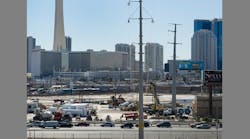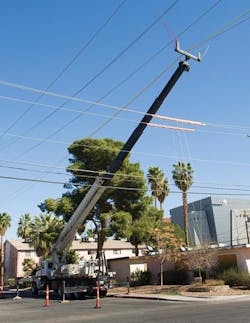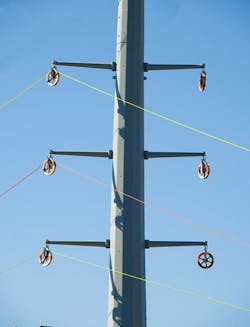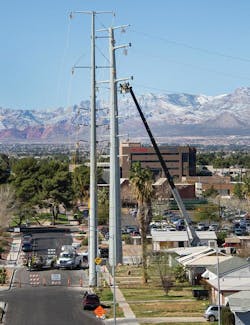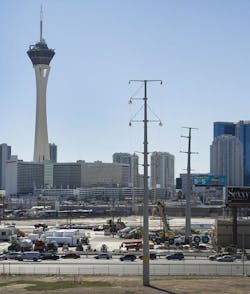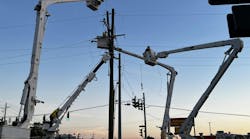Major construction projects always have their unsung heroes — those who quietly, safely and efficiently do their jobs so others can do theirs. Such is the case with a major transmission line in Las Vegas, Nevada, that must be moved and rebuilt to clear a path for the largest freeway improvement project in the state.
Known as “Project Neon,” this $1.5 billion undertaking by the Nevada Department of Transportation will make freeway-widening improvements over a short 3.7-mile stretch of interstate. The work will include new interchanges, new traffic lanes and a new high-occupancy vehicle network. This stretch of highway accommodates about 250,000 vehicles each day and more than 25,000 lane changes each hour.
Although Nevada drivers will soon notice the road construction and freeway improvements, almost no one is aware that transmission line engineers, utility planners and project managers have worked for several years to inconspicuously plan and remove 17 transmission line structures ranging in height from 115-ft to 125-ft tall. These poles were carrying three critical electrical circuits that serve the Las Vegas and Las Vegas Strip areas, and some were located just a few feet away from busy traffic lanes. The rerouting project also required the construction of 16 new structures that would route the power around the upcoming freeway construction area.
Scheduling the Project
NV Energy and its subcontractor, EC Source, planned for all of this work to be done in a short time frame and during the right time of the year. When southern Nevada temperatures climb above 100°F during the summer, every electrical circuit is critical to serve the air-conditioning and other energy needs of nearly 2 million people who live in the Las Vegas Valley. That’s why this work to remove and rebuild a triple-circuit transmission line, which carries conductors for two 138-kV and one 69-kV circuits, needed to be done during the cooler months when customer peak demands are significantly lower.
The team selected a four-month winter period to take the transmission circuits out of service and begin the removal process. Simultaneously, crews started constructing 16 new structures and stringing new circuits located away from the Project Neon construction area.
Removing the Conductor
The first deconstruction step was for crews in bucket trucks to unclip the line at each tower and install “travelers.” These travelers (pulleys) allowed workers to use ropes fed into wire pullers to guide the 19-year-old lines onto waiting spools.
Because of various cross-street issues and the crossing over the busy I-15, NV Energy had to coordinate with the Nevada Department of Transportation and the City of Las Vegas with specific traffic plans. Much of the work over these intersections and the removal of lines above the freeway was done at night when there was less traffic.
Removing the conductor that spanned I-15 required careful coordination with the Nevada Department of Transportation and the Nevada Highway Patrol. The one-night process included working with highway patrol officers to shut down the freeway for short intervals. The crews could then quickly disconnect a span of conductor, lower it to the ground, gather it up manually, and use a truck to partially pull it off the freeway. They repeated this process for each of the nine conductor lines as well as the upper static and fiber-optic lines.
Deconstructing the Towers
NV Energy originally built the existing tubular steel poles in tapered and stacked sections with a combination of foundation-bolted poles and direct-buried poles. Separation of the tapered sections was challenging, especially considering the dramatic hot and cold desert temperature changes, constant wind loads on the wires and the natural aging of the structure. In some cases, crews used crane pressure to pull off the top sections. Other times, they employed heavy hydraulic presses to separate the connections. And, in some cases, they split the tapered connection seam with a sawing tool. Where there was room, they could remove an entire pole and place it in a nearby lay-down yard to be cut and loaded onto large flatbed trailers.
All of this work was done in very tight conditions because of the proximity to the freeway, parallel roads, underpasses, businesses and some homes. Nearby work areas and lay-down yards were seldom available. To give the crews extra room, various road lanes needed to be closed. Also, shoulders and lanes on freeway on-ramps and off-ramps were occasionally shut down to accommodate crews, equipment and cranes. Added to the challenge was the fact that NV Energy and its contractor used a combination of cranes to handle the poles, which ranged in weight from 20,000 lb to as much as 70,000 lb.
Removing Legacy Foundations
Another challenge on the project involved removing existing concrete and steel foundations, some of which measured 7.5 ft by 22 ft and were 22 ft deep. When the transmission line was originally rerouted back in 1996, the crews abandoned these foundations because they didn’t impact the line, freeway or nearby business development. Project Neon, however, required NV Energy and its contractor to remove these foundations through excavation and drilling, cutting and pounding equipment.
Building the New Transmission Line
While dismantlement work was taking place, the tight project time frame required other workers to simultaneously start the process of installing new towers to carry the three transmission line circuits. Similar space constraints impacted this aspect of the relocation project.
Once the towers were up and travelers again in place, crews were ready to string the new circuits. Again, the process to install the lines across the busy interstate freeway required the most preparation and coordination. With bucket trucks in place, pullers and tensioners ready to reel, and pre-measured lengths of ropes at the ready, crews waited for the highway patrol to close the traffic flow from both directions. Once that happened, crew members walked four lead-line ropes across the freeway lanes, made the rope-to-rope connections, and then wound up the slack well above the freeway traffic. This process had to take place within a 15-minute time frame to allow the freeway to be reopened with the least amount of night-time traffic impact.
Focusing on Safety
Safe work practices for NV Energy, EC Source and its team of contractors on this project have been paramount, resulting in zero loss-time accidents or recordable incidents as defined by the Occupational Safety and Health Administration.
As important, this preparation work for the freeway expansion project will have unseen safety implications for decades to come. Case in point: This short 3.7 miles of freeway currently experiences more than 1,000 vehicle crashes each year. That three-per-day accident rate is expected to drop off dramatically once the freeway is fitted with more lanes, fewer lane changes, better interchanges and an HOV option.
Thanks in a small part to NV Energy and its construction partners, the citizens of Las Vegas, truckers who are passing through and millions of tourists will be safer.
Adelma Thom ([email protected]) is a senior project manager for NV Energy and has been with the utility since 1997.
Mike Curby ([email protected]) is a manager of the construction management team and has been with the company for 25 years.
